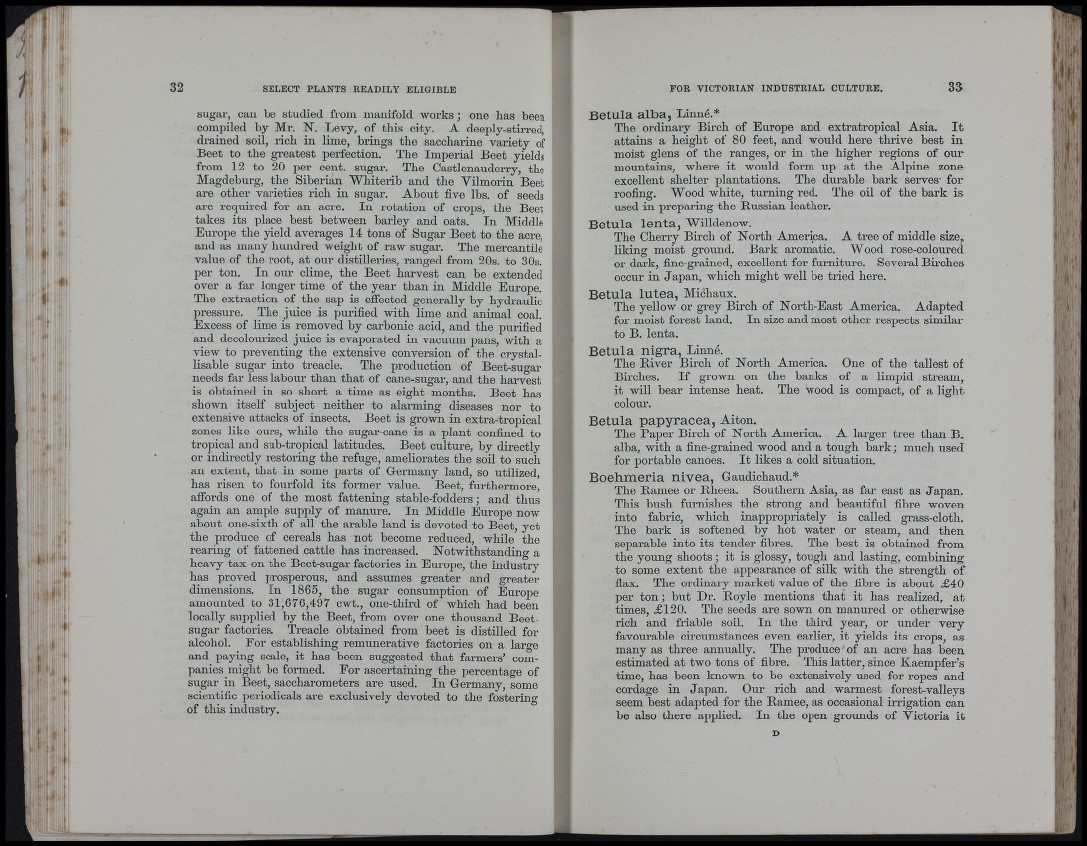
s
/
î:
, ¡tu
1' . I
[•
, Il
!
I , I I
sugar, can be studied from manifold works; one has been
compiled by Mr. N. Levy, of this city. A deeply-stirred,
drained soü, rich in lime, brings the saccharine variety of
Beet to the greatest perfection. The Imperial Beet yields
from 12 to 20 per cent, sugar. The Castlenauderry, the
Magdeburg, the Siberian Wbiterib and the Vümorin Beet
are other varieties rich in sugar. About five lbs. of seeds
are required for an acre. In rotation of crops, the Beet
takes its place best between barley and oats. In Middle
Europe the yield averages 14 tons of Sugar Beet to the acre,
and as many hundred weight of raw sugar. The mercantile
value of the root, at our distilleries, ranged from 20s. to 30s.
per ton. In our clime, the Beet harvest can be extended
over a far longer time of the year than in Middle Europe.
The extraction of the sap is effected generally by hydraulic
pressure. The juice is purified with lime and animal coal.
Excess of lime is removed by carbonic acid, and the purified
and decolourized juice is evaporated in vacuum pans, with a
view to preventing the extensive conversion of the crystal-
lisable sugar into treacle. The production of Beet-sugar
needs far less labour than that of cane-sugar, and the harvest
is obtained in so short a time as eight months. Beet has
shown itself subject neither to alarming diseases nor to
extensive attacks of insects. Beet is grown in extra-tropical
zones like ours, while the sugar-cane is a plant confined to
tropical and sub-tropical latitudes. Beet culture, by directly
or indirectly restoring the refuge, ameliorates the soil to such
an extent, that in some parts of Germany land, so utilized,
has risen to fourfold its former value. Beet, furthermore,
affords one of the most fattening stable-fodders; and thus
again an ample supply of manure. In Middle Europe now
about one-sixth of all the arable land is devoted to Beet, yet
the produce of cereals has not become reduced, while the
rearing of fattened cattle has increased. Notwithstanding a
heavy tax on the Beet-sugar factories in Europe, the industry
has proved prosperous, and assumes greater and greater
dimensions. In 1865, the sugar consumption of Europe
amounted to 31,676,497 cwt., one-third of which had been
locally supplied by the Beet, from over one thousand Beet-
sugar factories. Treacle obtained from beet is distilled for
alcohol. For establishing remunerative factories on a large
and paying scale, it has been suggested that farmers’ companies
might be formed. For ascertaining the percentage of
sugar in Beet, Saccharometers are used. In Germany, some
scientific periodicals are exclusively devoted to the fostering
of this industry.
Betula alba, Linné.*
The ordinary Birch of Europe and extratropical Asia. It
attains a height of 80 feet, and would here thrive best in
moist glens of the ranges, or in the higher regions of our
mountains, where it would form up at the Alpine zone
excellent shelter plantations. The durable bark serves- for
roofing. Wood white, turning red. The oil of the bark is
used in preparing the Russian leather.
Betula lenta, Willdenow.
The Cherry Birch of North America. A tree of middle size,,
liking moist ground. Bark aromatic. Wood rose-coloured
or dark, fine-grained, excellent for furniture. Several Bmches
occur in Japan, which might well be tried here.
Betula lutea, Michaux.
The yellow or grey Birch of North-East America. Adapted
for moist forest land. In size and most other respects similar
to B. lenta.
Betula nigra, Linné.
The River Birch of North America. One of the tallest of
Birches. I f grown on the banks of a limpid stream,
it will bear intense heat. The wood is compact, of a light
colour.
Betula papyracea, Alton.
The Paper Birch of NoiTh America. A larger tree than B.
alba, with a fine-grained wood and a tough bark; much used
for portable canoes. I t likes a cold situation.
Boebmeria nivea, Gaudicbaud.*
The Ramee or Rheea. Southern Asia, as far east as Japan.
This bush furnishes the strong and beautiful fibre woven
into fabric, which inappropriately is called grass-cloth.
The bark is softened by hot water or steam, and then
separable into its tender fibres. The best is obtained from
the young shoots ; it is glossy, tough and lasting, combining
to some extent the appearance of silk with the strength of
fiax. The ordinary market value of the fibre is about £40
per to n ; but Dr. Royle mentions that it has realized, a t
times, £120. The seeds are sown on manured or otherwise
rich and friable soil. In the third year, or under very
favourable circumstances even earlier, it yields its crops, as
many as three annually. The produce of an acre has been
estimated at two tons of fibre. This latter, since Kaempfer’s
time, has been known to be extensively used for ropes and
cordage in Japan. Our rich and warmest forest-valleys
seem best adapted for the Ramee, as occasional irrigation can
be also there applied. In the open grounds of Victoria it
D
II'.
i. 'il
I !.
i
àr